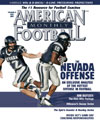AMERICAN FOOTBALL MONTHLY THE #1 RESOURCE FOR FOOTBALL COACHES
Article CategoriesAFM Magazine
|
Coach-By-Coach Responsibilities on Game Dayby: AFM Editorial Staff© More from this issue Coaches across America at every level require their players to be prepared for every game so they can be as effective and efficient as possible. If you do not require the same game day plan from your coaching staff in both responsibility and communication, then you are not being true to the requirements you place on your players. In researching another project for AFM, we found a wide discrepancy on game day responsibilities and communication among coaching staffs at various levels. The problem seemed to be a limited flow of information and not a detailed organizational game plan for coaches on game day. University of Central Florida Head Coach George O'Leary welcomed AFM to his football offices in Orlando in discussing the subject. While each staff has a different configuration, UCF places four coaches in the press ....The full article can only be seen by subscribers. Subscribe today!
|
|
|||||||
| HOME |
MAGAZINE |
SUBSCRIBE | ONLINE COLUMNISTS | COACHING VIDEOS |
Copyright 2025, AmericanFootballMonthly.com
All Rights Reserved





